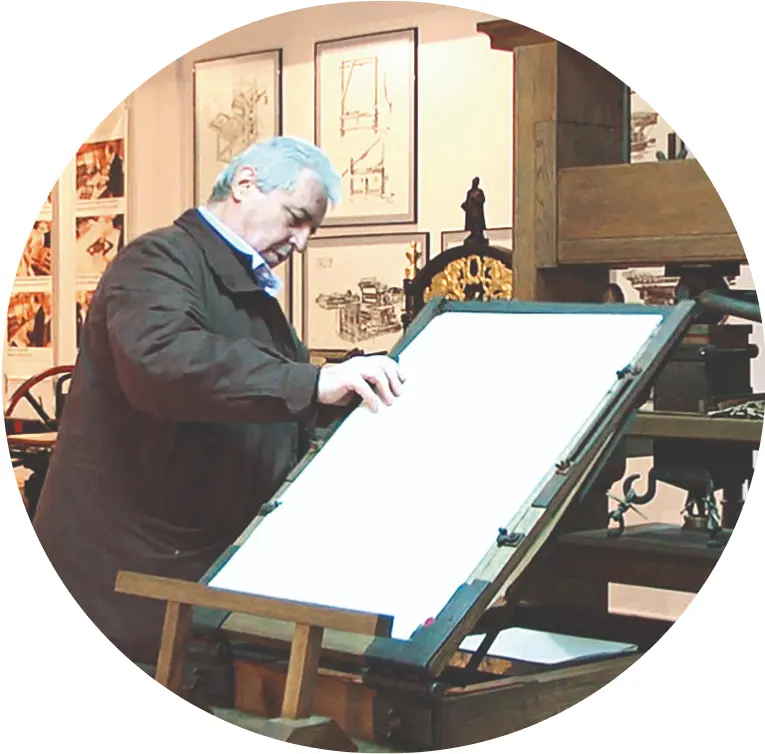

The history of the Museum of Typography is closely connected to the history of the newspaper Haniotika Nea.
As early as in the beginning of the 60’s, the founder of the newspaper Yannis Garedakis started working as a journalist in the historical newspaper of Hania Paratiritis and the Athens newspaper Vima, while at the same time, he was a member of the journalistic team that covered the newspapers of the Lambrakis Press Company in Crete for 20 years. In 1967, at a difficult period for newspapers, Haniotika Nea was published for the first time.
In the words of Yannis Garedakis:
“I was still a young man when I first entered the field of the regional press, working for the historical newspaper Paratiritis, founded by the great Cretan statesman Polychronis Polychronidis. Not by choice, I should add. I did not regret it. In fact, I can honestly say that I was rather fortunate.
There I was, all of a sudden, inside a basement, cooped up in a corner, preparing news transcripts – you see, there were no news agencies, no Internet, etc. back then – and making corrections. Across the room, in front of the typesetting benches, typographers assembled the type, letter by letter, composing the text.
Standing up for hours, quiet, as if they were attending a sacred ritual, they arranged letters with the composing stick forming sentences, then the galleys with complete texts and finally the pages of the newspaper.
Tired but proud at the end of the day. Last touch on their work – to me, it was a kind of caressing of the typographic plate, before the printing started.
Everyone expecting the first page, the second, then the third… To get the newspaper at three or four in the morning and then go to bed. Exhausted but at the same time clearly satisfied.
A few years later, those images came to mind when I started the publication of Haniotika Nea with the help of a few friends.
Printers and Linotype operators, working together in dark basements and sheds, were putting up a fight for every form of publication.
With love and respect towards the lifeless objects of their work…
Those typographic objects, printing machines, typographers and operators should not be forgotten.
Objects and machines should be maintained, the memory of typographers and operators should be honoured: that was the first thought that came to my mind.
The idea for the creation of a Museum of Typography started to spin around my head about three decades ago.
The years passed, and the newspaper blossomed economically thanks to its readers and advertising clients. At that point began the quest in the wonderful world of typography and its people and the journey leading to the foundation of the Museum. This quest, of course, would not have reached its destination had it not been for Michalis Grigorakis, my old friend and partner, who shared my dream and joined me in this journey.”
Gradually, we started collecting printing press machines and other artifacts connected with the art of typography, a process that led to the birth of the Museum of Typography, run by the newspaper Haniotika Nea. The Museum was inaugurated on May 2005.
For the realisation and evolution of the Museum of Typography, vital have been the contributions by Mihalis Grigorakis, for years responsible for the “Haniotika nea” archive, Koula Kampani, architect, Cornelius Schenk, former printer from the Netherlands, Antonis Papantonopoulos, printer – graphic designer, Yiorgos Maroulosifakis, former printer – journalist, Nikos Kosmadakis and Eleni Stavridi, graphic designers, Myrto Kontomitaki, museologist, Manolis Garedakis, publisher of “Haniotika Nea” and Elia Koumi, former director of the museum.
In 2012, the encounter with the typographer Antonis Papantonopoulos and the subsequent acquisition of his two remarkable exhibitions on the History of Writing and the Development of Typography and Graphic Arts led to the creation of a new wing, which doubled the size of the Museum and provided many new exhibits.
The collection of the museum is constantly enriched through the donations of important exhibits and the offer of expertise and services, by people from all over Greece.

